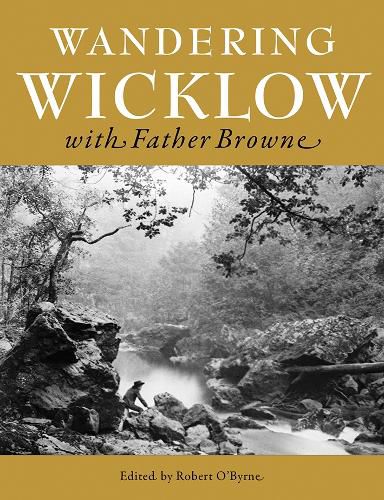Readings Newsletter
Become a Readings Member to make your shopping experience even easier.
Sign in or sign up for free!
You’re not far away from qualifying for FREE standard shipping within Australia
You’ve qualified for FREE standard shipping within Australia
The cart is loading…






Ireland’s finest photographer in the 20th century, Fr Frank Browne repeatedly visited County Wicklow across almost half a century. Over that time, he had the opportunity to capture images of this part of the country as it underwent change and yet, somehow, retained its essential character. The earliest photograph, for example, is of the Dargle Valley, a spot that looks much the same today as it did when Fr Browne first went there in 1910. This is made obvious by the colour replica photograph of the Dargle Valley, one of twenty colour replica photographs juxtaposed with Fr Browne’s originals in this book.
An introduction by the editor, Robert O'Byrne, allows the reader gain insight into this renowned photographer’s life, and also into the history of the various Wicklow locations included in the book.
Other pictures show landmark beauty spots such as the Powerscourt Waterfall and the Sugarloaf Mountain, as well as the rugged landscape of the Sally Gap. The monastic remains of Glendalough are exquisitely caught, along with the still waters of Lough Tay. The book is divided into six areas of Wicklow county, each a manageable day trip, which along with a handy guide map, offers readers the chance to follow in Fr Browne’s footsteps - and maybe take their own replica photographs!
While his eye was able to spot the timeless beauty of this rural idyll, Fr Browne also noted the modern and innovative, capturing key moments in the development of a newly-independent Ireland, such as the construction of the Poulaphouca Reservoir in the late 1930s and workers in the newly-opened Solus Teoranta Lightbulb Factory in Bray. Cars are few, but bicycles plentiful in his photographs. The advent of modern technology contrasts with traditional pastimes: a horse fair in Blessington, sheep dipping on a farm, a thatcher repairing the roof of an old cottage. He shows bustling preparations for the International Eucharistic Congress of June 1932, along with commercial activity in towns such as Arklow and Wicklow. New schools are shown being built in the first, older pursuits like fishing continue in the second.
Fr Browne’s ability to gain access everywhere means he was able to photograph many of Wicklow’s most famous historic houses, like Powerscourt before its interiors were tragically destroyed by fire, and Shelton Abbey which he visited just a year before the building and its contents were sold.
Whether you wish to take to the road, or remain an armchair traveller, this book is a companion to anyone interested in Ireland’s pictorial history, and especially the history of the county of Wicklow.
$9.00 standard shipping within Australia
FREE standard shipping within Australia for orders over $100.00
Express & International shipping calculated at checkout
Ireland’s finest photographer in the 20th century, Fr Frank Browne repeatedly visited County Wicklow across almost half a century. Over that time, he had the opportunity to capture images of this part of the country as it underwent change and yet, somehow, retained its essential character. The earliest photograph, for example, is of the Dargle Valley, a spot that looks much the same today as it did when Fr Browne first went there in 1910. This is made obvious by the colour replica photograph of the Dargle Valley, one of twenty colour replica photographs juxtaposed with Fr Browne’s originals in this book.
An introduction by the editor, Robert O'Byrne, allows the reader gain insight into this renowned photographer’s life, and also into the history of the various Wicklow locations included in the book.
Other pictures show landmark beauty spots such as the Powerscourt Waterfall and the Sugarloaf Mountain, as well as the rugged landscape of the Sally Gap. The monastic remains of Glendalough are exquisitely caught, along with the still waters of Lough Tay. The book is divided into six areas of Wicklow county, each a manageable day trip, which along with a handy guide map, offers readers the chance to follow in Fr Browne’s footsteps - and maybe take their own replica photographs!
While his eye was able to spot the timeless beauty of this rural idyll, Fr Browne also noted the modern and innovative, capturing key moments in the development of a newly-independent Ireland, such as the construction of the Poulaphouca Reservoir in the late 1930s and workers in the newly-opened Solus Teoranta Lightbulb Factory in Bray. Cars are few, but bicycles plentiful in his photographs. The advent of modern technology contrasts with traditional pastimes: a horse fair in Blessington, sheep dipping on a farm, a thatcher repairing the roof of an old cottage. He shows bustling preparations for the International Eucharistic Congress of June 1932, along with commercial activity in towns such as Arklow and Wicklow. New schools are shown being built in the first, older pursuits like fishing continue in the second.
Fr Browne’s ability to gain access everywhere means he was able to photograph many of Wicklow’s most famous historic houses, like Powerscourt before its interiors were tragically destroyed by fire, and Shelton Abbey which he visited just a year before the building and its contents were sold.
Whether you wish to take to the road, or remain an armchair traveller, this book is a companion to anyone interested in Ireland’s pictorial history, and especially the history of the county of Wicklow.